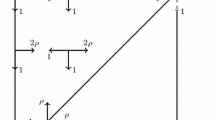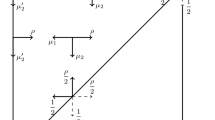Abstract
We consider two parallel M/M/∞ queues. All servers in the first queue work at rate μ1 and all in the second work at rate μ2. A new arrival is routed to the system with the lesser number of customers. If both queues have equal occupancy, the arrival joins the first queue with probability ν1, and the second with probability ν2 = 1−ν1. We analyze this model asymptotically. We assume that the arrival rate λ is large compared to the two service rates. We give several different asymptotic formulas, that apply for different ranges of the state space. The numerical accuracy of the asymptotic results is tested.
Similar content being viewed by others
References
I. Adan, G.J. van Houtum and J. van der Wal, Upper and lower bounds for the waiting time in the symmetric shortest queue problem, Ann. Oper. Res. 48 (1994) 197–217.
I.J.B.F. Adan, J. Wessels and W.H.M. Zijm, Analysis of the symmetric shortest queue problem, Comm. Statist. Stochastic Models 6 (1990) 691–713.
I.J.B.F. Adan, J. Wessels and W.H.M. Zijm, Analysis of the symmetric shortest queue problem with threshold jockeying, Comm. Statist, Stochastic Models 7 (1991) 615–627.
I.J.B.F. Adan, J. Wessels and W.H.M. Zijm, Analysis of the asymmetric shortest queue problem, Queueing Systems Theory Appl. 8 (1991) 1–58.
I.J.B.F. Adan, J. Wessels and W.H.M. Zijm, Matrix-geometric analysis of the shortest queue problem with threshold jockeying, Oper. Res. Lett. 2 (1993) 107–112.
M. Alanyali and B. Hajek, On large deviations of Markov processes with discontinuous statistics, Ann. Appl. Probab. 8 (1998) 45–66.
M. Alanyali and B. Hajek, On large deviations in load sharing networks, Ann. Appl. Probab. 8 (1998) 67–97.
C.M. Bender and S.A. Orszag, Advanced Mathematical Methods for Scientists and Engineers (McGraw Hill, New York, 1978).
J.W. Cohen and O.J. Boxma, Boundary Value Problems in Queueing System Analysis (North Holland, 1983).
L. Flatto and H. McKean, Two queues in parallel, Commun. Pure Appl. Math. 30 (1977) 255–263.
P.J. Fleming and B. Simon, Heavy traffic approximations for a system of infinite servers with load balancing, Probab. Eng. Info. Sci. 13 (1999) 251–273.
M.I. Friedlin and A.D. Wentzell, Fluctuations in Dynamical Systems Subject to Small Random Perturbations (in Russian) (“Nauka”, Moscow, 1979).
S. Halfin, The shortest queue problem, J. Appl. Probab. 22 (1985) 865–878.
R. Hariharan, V.G. Kulkarni and S. Stidham, Optimal control of two infinite server queues, in: Proceedings of the 29th IEEE Conference on Decision and Control (1990) Hawaii.
J.B. Keller, Rays, waves and asymptotics, Bull. Amer. Soc. 84 (1978) 727–750.
J. Kevorkian and J.D. Cole, Perturbation Methods in Applied Mathematics (Springer-Verlag, New York, 1981).
J.F.C. Kingman, Two similar queues in parallel, Annals Math. Statist. 32 (1961) 1314–1323.
C. Knessl, A new heavy traffic limit for the asymmetric shortest queue problem, Eur. J. Appl. Math. 10 (1999) 497–509.
M. Reiman, Some diffusion approximations with state space collapse, in: Modelling and Performance Evaluation Methodology, eds., A.V. Balakreshnan and M. Thomas (Springer-Verlag, 1984) pp. 209–240.
S.R.E. Turner, A join the shorter queue model in heavy traffic, J. Appl. Probab. 37 (2000) 212–223.
P.P. Wang, Workload distribution of discrete time parallel queues with two servers, Naval Res. Logist. 47 (2000) 440–454.
P. Wu and M.J.M. Posner, A level-crossing approach to the solution of the shortest queue problem, Oper. Res. Lett. 21 (1997) 181–189.
H. Yao and C. Knessl, On the infinite server shortest queue problem: non-symmetric case, MSCS Technical Report, University of Illinois at Chicago (2004).
H. Yao and C. Knessl, On the infinite server shortest queue problem: symmetric case, Stochastic Models 21 (2005) 101–132.
Y.Q. Zhao and W.K. Grassman, The shortest queue model with jockeying, Naval Res. Logist. 37 (1990) 773–787.
Author information
Authors and Affiliations
Corresponding author
Additional information
AMS subject classification 60K25 60K30 34E20
Rights and permissions
About this article
Cite this article
Yao, H., Knessl, C. On the infinite server shortest queue problem: Non-symmetric case. Queueing Syst 52, 157–177 (2006). https://doi.org/10.1007/s11134-006-5500-z
Received:
Accepted:
Issue Date:
DOI: https://doi.org/10.1007/s11134-006-5500-z




